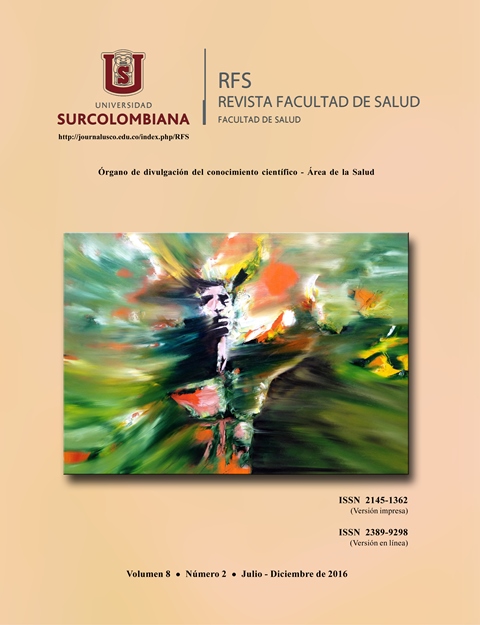Characterization of upper digestive tract endoscopy in a Colombian pediatric population
##plugins.themes.bootstrap3.article.main##
Upper digestive tract endoscopy in pediatric patients is a low-risk diagnostic tool that helps to visualize findings and important elements for therapeutic decision making. Objective. To characterize the findings in patients under 18 years old who underwent upper gastrointestinal endoscopy, in a period of four years, between 2011 and 2015, at two endoscopy centers in the city of Neiva. Materials and methods. It is a documentary retrospective study, based to reports of upper gastrointestinal endoscopy studies. It was performed in children under 18 years in database of two endoscopy centers at Neiva (Colombia). The study was carried out between from January 2011 to January 2015, We documented 258 patients and data such as gender, age, endoscopic diagnosis were obtained. Data analysis was done by using SPSS version 19.0 through descriptive statistics. Results. 258 records endoscopies between zero and 18 years were found, the distribution by gender was female with 59.3% and female 39.5%, the distribution by age group was: kids 40%, followed by toddlers 26%, teenagers 21% and babies13%. endoscopic diagnoses more frequent were esophagitis in toddlers (8, 9%, n = 6). Gastritis occurred in 79% (n = 203) of all patients, chronic gastritis were 50, 2% (n = 102) of them. Biopsies were taken in 77% of all cases. Conclusions. Endoscopic findings in pediatric population showed that esophagitis was presented more frecuently in kids and toddlers, it could be related to multiple factors. Chronic gastritis was presented in 80% of patients and sedation was used in 100% of patients, It cases was performed most often by nonanesthesiologists.
Downloads
##plugins.themes.bootstrap3.article.details##
M.A Gómez, O.F. Ruiz, J. Riveros. Utilidad de la endoscopia digestiva alta diagnóstica en pacientes menores de 18 años. Rev Colom Gastro. 2014; 29 (2):112-16.
Sheiko MA, Feinstein JA, Capocelli KE, Kramer RE. The concordance of endoscopic and histologic findings of 1000 Pediatric EGDs. Gastrointest Endosc. 2015; 81(6):1385–1391.
Fox VL. Pediatric endoscopy. Gastro Endos Clinics Of North America. 2000; 10: 175-94.
Zahavi I, Arnon R, Ovadia B, et al. Upper gastrointestinal endoscopy in pediatric patient. Israel Journal of Medical Science. 1994; 30: 664-67.
Gómez, J. Barrio, L. Izquierdo et al. Gómez J, Barrio J, Izquierdo R, Simón G. Estudio retrospectivo sobre la endoscopia pediátrica desarrollada en un servicio de endoscopias de adultos. Rev Esp Enf Dig. 2010; 102(2):100-07.
M.A Gómez, O.F. Ruiz, J. Riveros. Utilidad de la endoscopia digestiva alta diagnóstica en pacientes menores de 18 años. Rev Colom Gastro, 2014; 29 (2):112-16.
Carvalho MA, Machado NC, Ortolan EV, Rodrigues MA. Upper Gastrointestinal Histopathological Findings in Children and Adolescents With Nonulcer Dyspepsia With Helicobacter Pylori Infection. J Pediat Gastr Nutr. 2012; 55 (5): 523–529.
Campanozzi A, Boccia G, Pensabene L. Prevalence and Natural History of Gastroesophageal Reflux: Pediatric Prospective Survey, Pediatrics 2009; 123 (3): 779-83.
Tolia V, Gilger MA, Barker PN, Illueca M. Healing of Erosive Esophagitis and Improvement of Symptoms of Gastroesophageal Reflux Disease After Esomeprazole Treatment in Children 12 to 36 Months Old. J Pediatric Gastr and Nutr. 2015; 60 (7): S31-6.
Fildes A, van Jaarsveld CH, Llewellyn C, Wardle J, Fisher A. Parental Control Over Feeding in Infancy. Influence of Infant weight, appetite and feeding method. Appetite. 2015; 91: 101-06.
Martonffy Al. Oral Health: Prevention of Dental Disease. FP Essent. 2015; 428: 11-5.
Kalach N, Papadapoulos S., Asmar E. In French Children, Primary Gastritis Is More Frequent Than Helicobacter Pylori Gastritis. Dig Dis Sci. 2009; 54 (9):1958-1965.
Serrano CA, Toledo H, et al. Iron Deficiency and IL1â Polymorphisms in Helicobacter pylori-infected Children. Helicobacter. 2016; 21 (2): 124-30.
Kramer RG. Lerner DG, Lin T, et al. Management of Ingested Foreign Bodies in Children: A Clinical Report of the NASPGHAN Endoscopy Committee. J Pediatr Gastr Nutr. 2015; 60 (4): 562-74.
Muñoz MP, Maluje R, Saitua F. Cuerpo Extraño Gastrointestinal en Niños. Rev Chil Pediatr 2014; 85(6): 682-89.
Forero EA. NAAP: Sedación profunda con propofol para endoscopia digestiva administrada por no anestesiólogos. Posición del endoscopista en el 2011. Rev Col Gastroenterol. 2011; 26 (2): 107-16.










